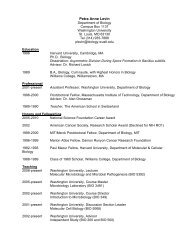Guide for doing FRAP with Leica TCS SP2 - Biocenter
Guide for doing FRAP with Leica TCS SP2 - Biocenter
Guide for doing FRAP with Leica TCS SP2 - Biocenter
Create successful ePaper yourself
Turn your PDF publications into a flip-book with our unique Google optimized e-Paper software.
<strong>FRAP</strong>Estimation ofparametersCalculation of the mobile fractionIn an “artificial” in vitro experiment, such as the diffusionof FD 464 in aqueous solution all particles will besubject to Brownian motion and there<strong>for</strong>e spread bydiffusion. However, in real cells the situation can bemore complicated, because biomolecules/proteinsinteract (bind to) each other. This can lead to a substantialfraction of the labelled molecule, which isbound and there<strong>for</strong>e does not diffuse, the so-calledimmobile fraction (1 – M f , see below). Only the mobilefraction M f can move. Figure 4 illustrates the effect ofan immobile fraction on the <strong>FRAP</strong> curve.Calculation of t 1/2The time it takes <strong>for</strong> the fluorescence to recover to50% of the asymptote (plateau) intensity is called recoveryhalf-time, t 1/2 . It can be used to compare relativerecovery rates, if it is not possible to estimate Dby fitting a diffusion equation to the data. t 1/2 can beeither determined visually from a graph plotting fractionalfluorescence vs. time or by solving (comp.Snapp et al. 2003):F(t) = 100 x (F 0 + F inf (t/t 1/2 )) / (1+(t/t 1/2 )) (3)Note: The recovery half-time strongly depends on thebleach geometry as well as numerous other experimentalparameters (see Table “Experimental Conditions”).In order to compare experiments <strong>with</strong> eachother they should be conducted <strong>with</strong> identical conditions,bleach ROI geometry and ROI size.Estimation of the diffusion coefficient DInstead of using equation (3) one could fit an exponentialfunction as empirical approach to the dataset:Figure 4Only the mobile fraction can diffuse. As a resultthe fluorescence level becomes lowerthan 1 (100%).The mobile fraction M f can be calculated directlyfrom the integrated intensities <strong>with</strong>in the bleach ROI(ROI 1 in Figure 5, raw) and a ROI including the wholecell (ROI 2 in Figure 5, raw) according to:With F precell = prebleach intensity <strong>with</strong>in the whole cellF infcell = postbleach intensity (whole cell) at equilibriumF pre = bleach ROI prebleach intensityF(0) = bleach ROI intensity at time 0Note: The first term in eqn. (2) contains a correction<strong>for</strong> photobleaching during the acquisition of the postbleachimages. The latter leads to a fluorescenceloss over time, so the equilibrium intensity would beunderestimated. Without this correction the recoverycould not reach 100 % even <strong>with</strong> M f = 100%. If a“correction <strong>for</strong> fluorescence loss due to photobleaching”was per<strong>for</strong>med already (see above), the firstterm eqn. (2) has to be omitted.(2)y = a ∗ (1-exp(-t/τ)) + c (4)This is implemented in the <strong>Leica</strong> <strong>FRAP</strong> wizard andyields the time constant t of the recovery as well asthe recovery half-time t 1/2 :t 1/2 = τ ∗ ln 2 (5)In the original publication by Axelrod et al. (1976) asomewhat complicated expression is given <strong>for</strong> thetemporal behaviour of fluorescence recovery. In thecase the nature of the transport is pure diffusion theysuggest to use the following simplified equation toestimate the diffusion coefficient:D = 0.88 ∗ w 2 /(4 t 1/2 ) (6)With w ... radius of bleached areaHowever, this equation makes the assumptions thatthe bleached area is a spot (disc) and that diffusionoccurs only laterally (in 2D as in membranes). In someexperiments these assumptions may not apply. Insuch a case calculations will only serve as a roughestimation.8Confocal Application Letter











